It’s no wonder marketers love creative briefs: A good one sets you up for success with a high-level game plan and a clear objective.
A creative brief is a roadmap that takes a project from ideation to completion. It ensures that the project's scope, timeline, key stakeholders, and purpose are communicated clearly.
The creative brief is the single source of truth for everyone working on a project. If questions arise or tasks become unclear, the brief will steer things in the right direction.
Table of Contents
- What is a creative brief?
- Creative Brief Outline
- How to Write a Creative Brief
- Creative Brief Templates
- Types of Creative Briefs
- Creative Brief Examples
The Purpose of a Creative Brief
Whether you’re a consultant pitching a creative brief to a client or a project manager presenting a brief to your team, start by speaking with the project stakeholders.
These discussions will clarify the company's mission, project goals, and challenges your team faces. Then, you’ll have enough information to write a compelling brief that focuses on what’s really important to your company or client.
How a Creative Brief Works
Creative briefs are pretty standard documents within just about every marketing, advertising, or design team.
For smaller projects that live in-house (like designs, templates, marketing assets, etc.) the brief is owned by the team who will be executing on it.
This is usually the creative team, but this team can fall within the brand department or even live within marketing.
For more advanced, long-term projects that involve an agency, the creative brief is owned by the creative team or agency that will be executing the work.
This is because they‘ll work closely with the stakeholders on the project to understand what is needed, plus they’ll bring their own expertise and competitive research to the brief that the internal team may not have access to.
These creative briefs are less common, so we‘ll focus mostly on the day-to-day creative briefs you’re more likely to use. Here's how they work.
- Step 1. The teams who need assistance from the creative team will retrieve the creative brief template from a repository like OneDrive, Google Drive, or an online form.
- Step 2. The team requesting the project will complete the brief according to their team's needs and goals, explaining them clearly to the team(s).
- Step 3. From there, the brief is sent back to the creative team for review. They'll be looking for timelines, resources, and budget requirements.
- Step 4. If they have any questions, they'll go back to the team who wrote the brief and finalize the details.
- Step 5. After that, the project is kicked off, sometimes with the help of a project manager, who will check in with stakeholders and keep everything on schedule, within scope, and within budget.
- Step 6. Once the project is complete, both teams will review the deliverables against the creative brief to ensure everything is completed correctly.
The format of a company's creative brief might vary to suit the needs of the project or client. Below is a simple outline that will be the foundation of your creative brief.
It includes the most important steps in the creative process and information relevant to stakeholders involved in the project.
Once you’re fully informed and ready to write, use the following steps to draft yours. To make it even easier, I've included a fill-in-the-blank template in the last step.
1. Decide on a name for the project.
The first step in developing a creative brief is deciding on a project name. This might sound simple, but it's one of the most critical components of a creative brief. A few words or a short sentence should work just fine.
If you're building a campaign around a brand new product or service, the campaign name will be the first time many members of your team will be introduced to it. And without a specific and clear campaign name, people will make up their own terminology, which can alter the intent of the campaign.
If you're launching a product, identify the call to action for the target audience and center the name around that.
Here are a few examples of fictional campaign names:
- Search for Adventure. A scavenger hunt-themed amusement park.
- Don't Forget Your Memories. A photo frame company.
- What's hotter than PepperCo hot sauce? A hot sauce brand.
2. Write about the brand and summarize the project’s background.
If you work in an agency setting, including the company’s background is non-negotiable, as your team is likely handling several client campaigns at once.
But even if you're developing a creative brief for an in-house project, include this info for new hires, freelancers, and vendors.
- Tailor this to the project at hand — it shouldn't be a general history of the company or a paragraph pasted from the about page.
- Set the scene with one or two sentences that sum up the brand’s mission.
- Follow this with a few sentences that give background on the brand and what led to the project's development.
While some creatives have compiled this into a quick paragraph, others separate it with headers like “Brand Statement” and “Background.”
Here are some questions to consider when writing a company background for your creative brief:
- Has the company launched a campaign like this before?
- Why is the company choosing to launch this campaign right now?
- What's happening in the market and how will this campaign respond to it?
3. Highlight the project objective.
Here is where the creative brief gets more specific.
- The project objective should briefly explain the project's purpose, timeline, and target audience. This can be done in a sentence or two, but you can get creative and stylize it in sections.
- Emphasize why the project needs to happen. The goal aspects will help you and your team align on the project’s expectations.
- Explain what a successful project looks like and how it will benefit the company. If the company or client hasn’t identified any major challenges, you can focus this section on goals and objectives.
Pro tip: Writing a project objective is very similar to writing a goal, so take a look at our article on writing goals and objectives.
Here’s an example I made using a Canva template and Claude.ai that offers separate sections for the problem and goals.
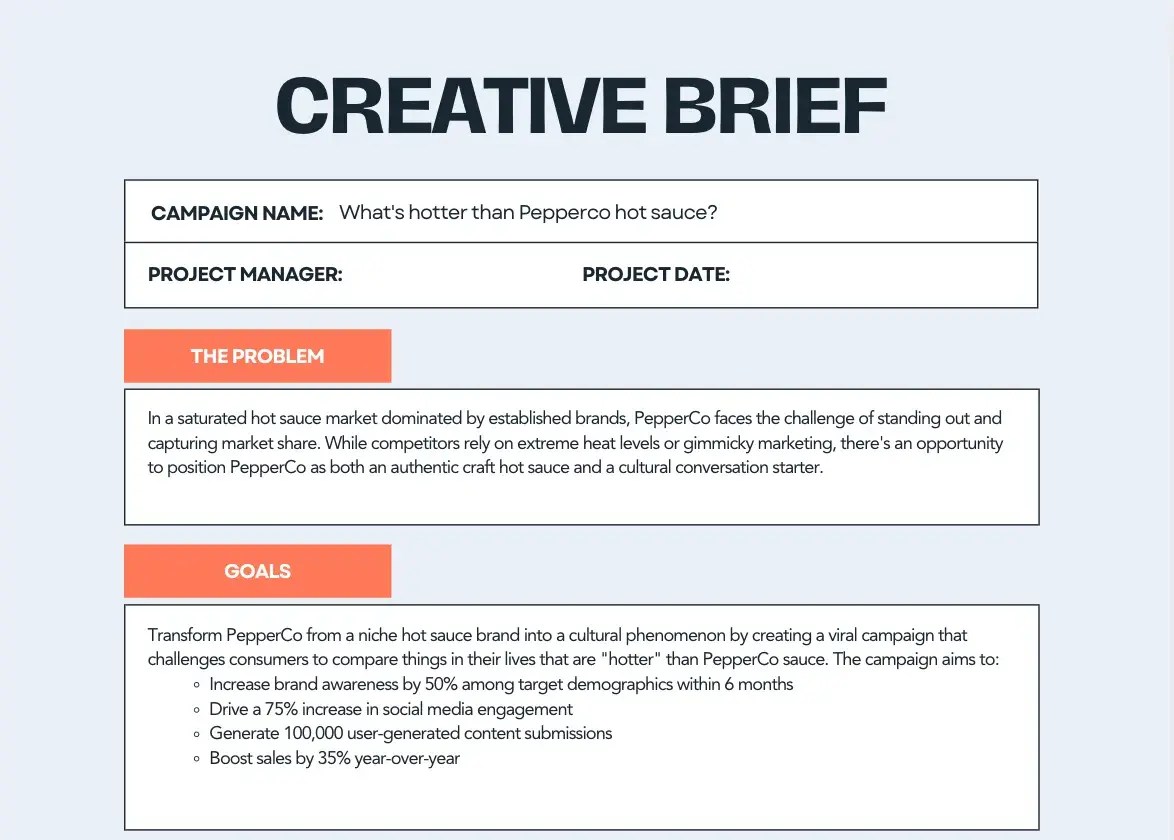
4. Describe the target audience.
Next, define your project’s target audience. This is the segment of your market that will directly benefit from the product or service you’re launching.
You can take audience segmentation a step further by identifying a primary and secondary audience. Doing so will give your team more freedom to explore creative ideas that might resonate with one group more than the other.
When crafting the target audience section, be sure to include the following:
- Demographics. Simple demographic information gives your team insight into exactly who the audience is. This includes data points like age, income, education, ethnicity, and occupation.
- Behaviors. Buying behaviors, trends, and other customer history make up the target audience behaviors. These provide important context to the creative brief because they explain where the customer is in their buyer journey.
- Psychographics. This is how the audience thinks and feels about your brand and the product or service you sell, in general.
- Geographics. Digital, physical, and hybrid campaigns will benefit from having geographics stated explicitly in the creative brief so that media buyers can price ad slots in each market.
Pro tip: Your creative brief shouldn't be too long, and this section can take up quite a bit of space. To make this section more digestible, consider using buyer personas.
Here’s how I explained a new product’s target audience in the example above:

5. Interpret the competitive landscape.
Knowing what your competitors are doing is advantageous for the whole team.
You can use competitive data to come up with new ideas, learn from their failed projects, or build a project that improves on a strategy they’ve used in the past.
Include a quick list of competitors with similar product or service offerings.
Briefly list a few things your company has in common with them, how your brand has differentiated itself already, and a few areas where this project can help you get ahead.
6. Prepare the key message.
Developing the key message can be the most difficult part of the creative brief because stakeholders may have differing opinions.
The key message includes:
- the pain point,
- what the audience's experience might be like without the pain point,
- and the benefit they‘ll receive as a result of your company’s solution.
This framework places the customer in the campaign’s spotlight. Instead of telling them what this product or service could do for them, it positions them as the main character in the journey from problem to solution.
Pro tip: To get buy-in faster, try this simple trick. Ask yourself, “We're launching this project, so what?” The “so what?” is your key message. It explains why your target audience should stop what they're doing and pay attention to your campaign.
7. Define the key consumer benefit.
If you‘re launching a new product, there are likely several features and benefits that the target audience will experience when they decide to purchase it. However, it’s very difficult to structure a campaign around several different features.
That's why marketers and creatives use something called a key consumer benefit (KCB) in the creative brief to keep everyone aligned on the primary benefit being communicated.
To choose the right KCB, you'll want to get input from the project stakeholders and rely on consumer data to guide the decision.
Pro tip: Your KCB won't always be the fanciest feature of your product. The benefit that solves the biggest problem for your audience is a great choice for the KCB.
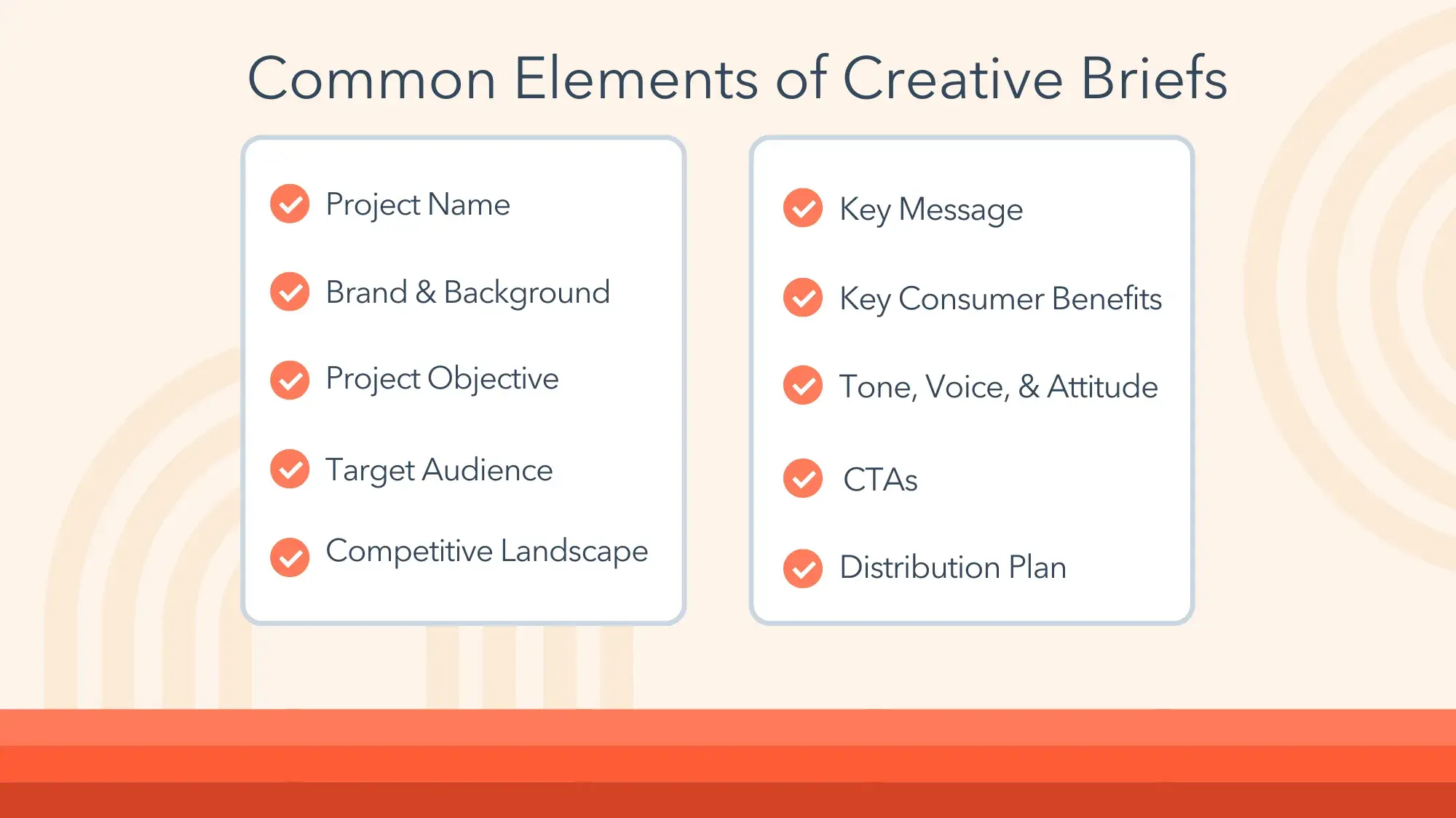
8. Select an attitude.
The tone and voice of your campaign create the overall attitude, which should be consistent throughout every creative element.
- Identify a few adjectives that describe the attitude of the campaign. This can help copywriters draft copy that sends the correct message within the right context. Graphic designers can use colors and techniques to bring the attitude to life.
- Note the appropriate voice for your audience. While some audiences, like those in the business world, prefer more formal language, others might engage more with a casual, relatable tone.
Pro tip: Use a thesaurus to find specific words that evoke nuanced emotions and attitudes for a hyper-targeted campaign.
9. Determine the best call to action.
Finally, your audience needs something to do once they see your campaign.
A CTA doesn’t have to be a physical action — it could aim to change thoughts and perceptions about your brand.
Your creative brief might include several different CTAs, especially if you have a primary and secondary target audience. But it's a good idea to have one primary CTA that drives the project objective we talked about earlier.
10. Draft the distribution plan.
When the project is done, you’ll need to make sure your audience actually sees it. List a few channels or platforms on which you plan to announce the launch, as well as any promotional content you plan to create.
When drafting this section, think about your target audience. Don’t waste time on a promotional strategy they won’t see.
For example, if you’re promoting a project to Gen Z, you’ll want to invest in social media rather than billboards or newspaper ads.
11. Share the creative brief with stakeholders.
Once you’ve drafted a creative brief, share it with the team you’ll be working with. You’ll also want to circulate it around the company via Slack, email, or presentations.
If you’re an outside consultant, encourage your clients to share the brief internally.
As you or your clients spread awareness, you should be open to answering questions or taking feedback from colleagues in case they have any great ideas.
This strategy will improve team alignment, increase support of the project, and ensure that all of your colleagues are on the same page.
Follow Along with HubSpot's Free Creative Brief Templates
Creative Brief Templates
Having trouble with the flow and organization of your brief? Here are simple templates that could help. Copy and paste into a document and fill in the blanks. You can also add to the templates or adjust them as needed for your project.
[Insert company or client logo at the top along with the project name.]
COMPANY BACKGROUND:
For ___ years, ______ [Brand Name] has been serving customers in the ____________ [group/job field/geographical area] with ____________________ .
[Brand Name] has made achievements including __________,__________, and ___________. We have also launched marketing campaigns that have touched on ____________,________, and ____________. With the launch of _________ [project name] they hope to ___________.
PROJECT OBJECTIVE:
With this project, the company aims to solve problems related to ____________________, while also expanding on ___________ and improving on _____________.
TARGET AUDIENCE:
Our target audience is ____ [gender], in the age range of _ and _, and live areas like ____, _____, and ______. They enjoy _____, dislike ______, and might work in fields like _____, _____, and _____. They want more of ________ and their daily pain points include ________.
Their favorite products might include _______ and ______. They learn about these products through channels including ________, _________, and _______.
COMPETITORS:
Our three biggest competitors [are/will be] ________, ________, and _______. These competitors offer _____, ______, and ______. We are ahead of them in _____ and ______, but we are behind when it comes to product offerings like __________ and _________.
KEY MESSAGE:
The target audience is experiencing __________ [pain point], but with our newest project ___________, they‘ll get to experience _________ [new experience without the pain point]. That’s what makes ______ [solution] an unrivaled solution within the market.
KEY CONSUMER BENEFIT:
________ [feature] is the best way for our target audience to experience _____ [benefit].
ATTITUDE:
[Include three to five adjectives that describe the tone and voice of the project.]
CALL TO ACTION:
When the target audience sees our campaign, they will [feel/think/do] _________.
DISTRIBUTION:
We will promote the launch on platforms and channels that our demographic regularly engages with. These will include ________, ________, and _______.
We will also release content including _______, _______, and ________ to gain attention from our audience and inform them of the project.
Below are a few messages we will use:
- _________________________________________________.
- _________________________________________________.
- _________________________________________________.
Here are more templates to consider:
1. Simple Campaign Creative Brief
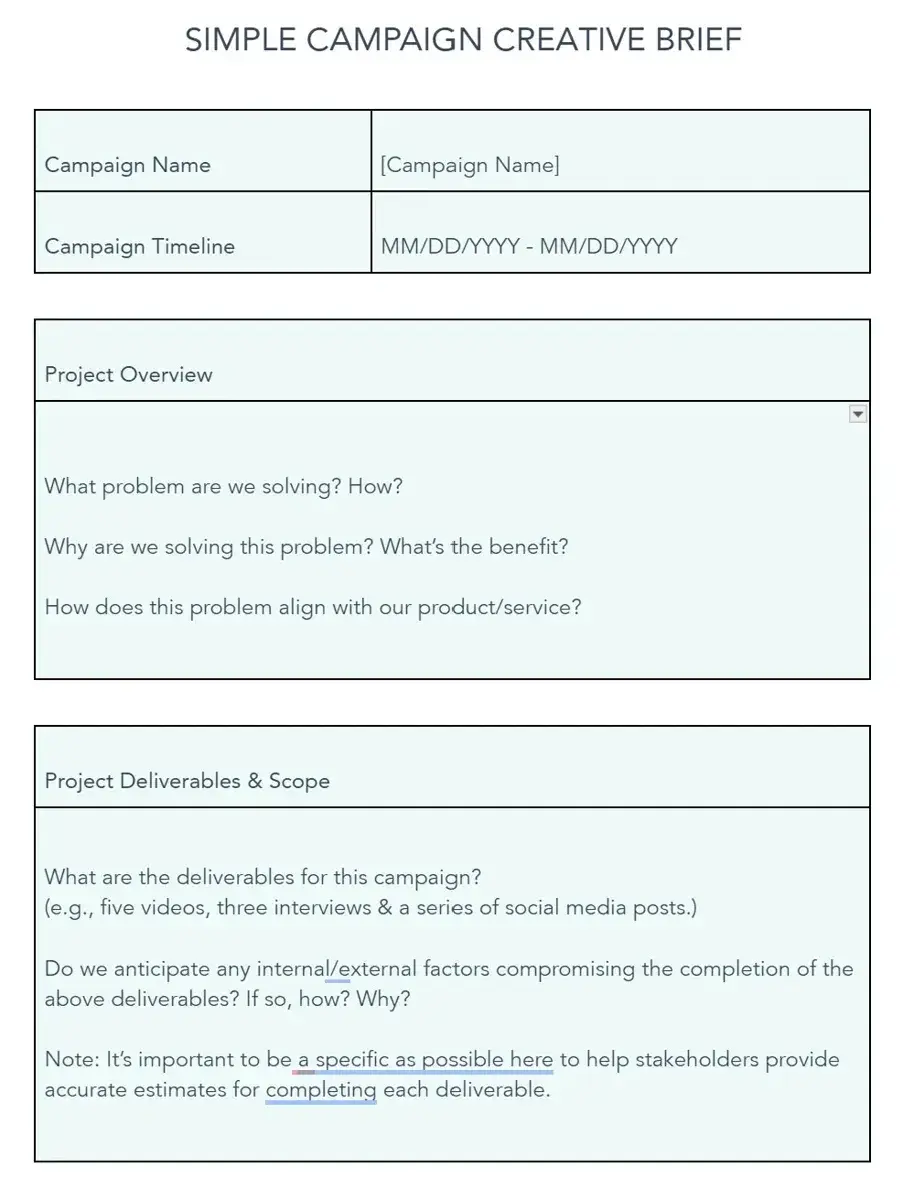
2. Video Creative Brief
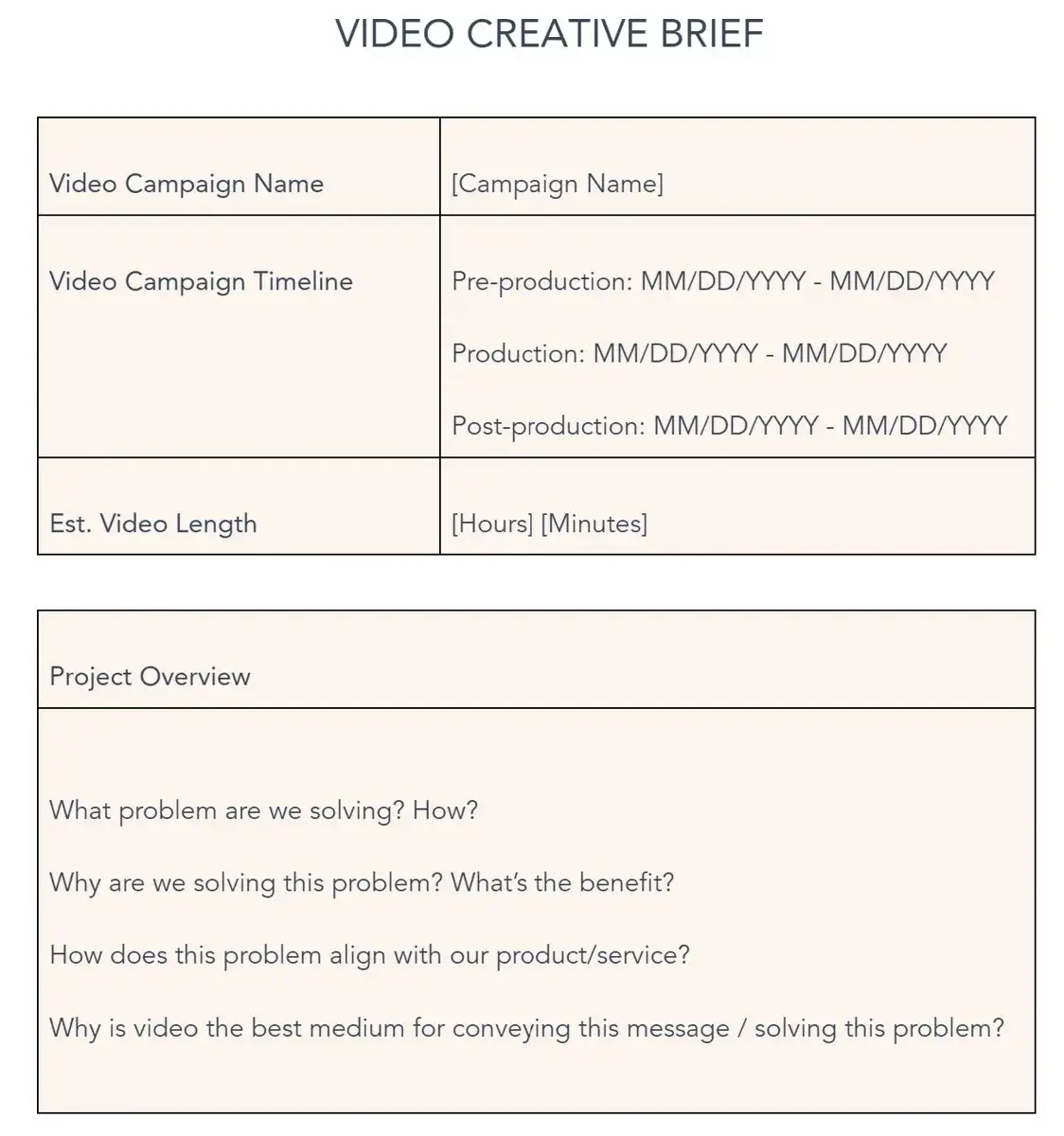
3. Simple Client Creative Brief
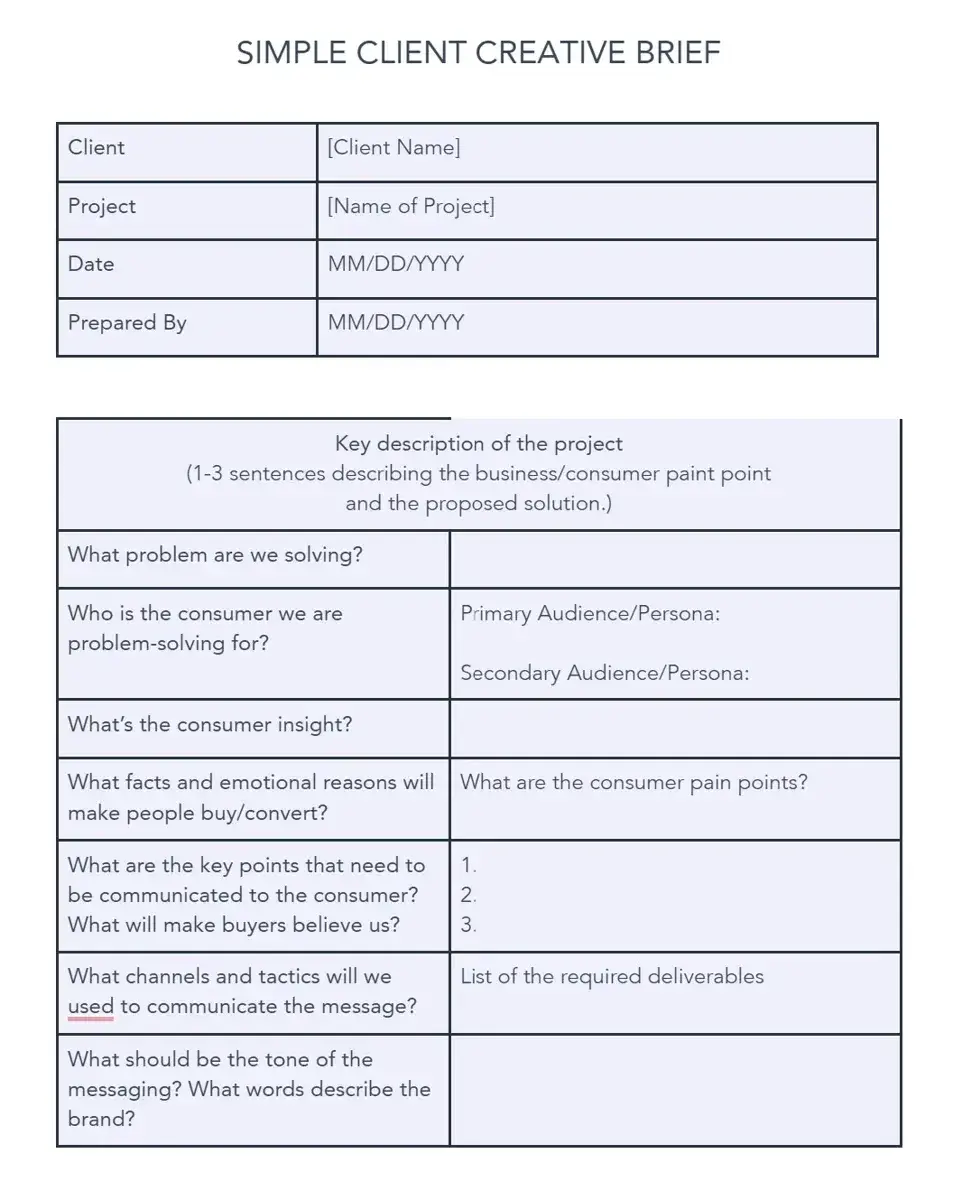
Types of Creative Briefs
Creative briefs serve several purposes in the communications field. Marketers, designers, and advertisers use them differently.
Depending on your role, your team, and the project you're working on, one might be more effective than the other.
Below are some of the most common types of creative briefs used across industries today plus examples of what they might look like.
1. Marketing Creative Briefs
A marketing creative brief is used to bring campaigns to market.
This type of creative brief can be used for both new and existing campaigns. Broad business goals and strategies to accomplish them are usually included in this type of creative brief.
It's also not uncommon to see revenue goals and a budget included in a marketing creative brief.
Simple Marketing Creative Brief Example
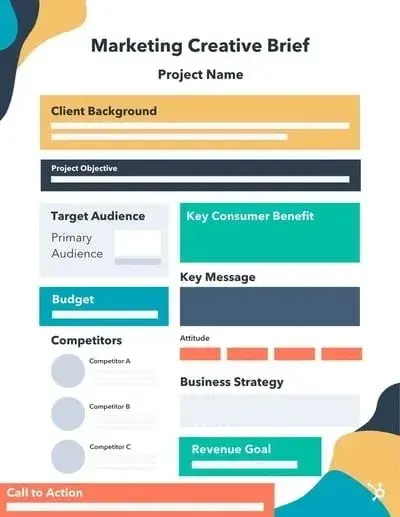
2. Product Design Creative Briefs
Product design creative briefs outline the go-to-market strategy for a new product or feature launch.
Product marketers are responsible for developing this type of brief in conjunction with the product manager. This brief describes the features of the product and how they benefit the audience.
Unique features of this type of creative brief include product documentation and product descriptions.
Product Design Creative Brief Example
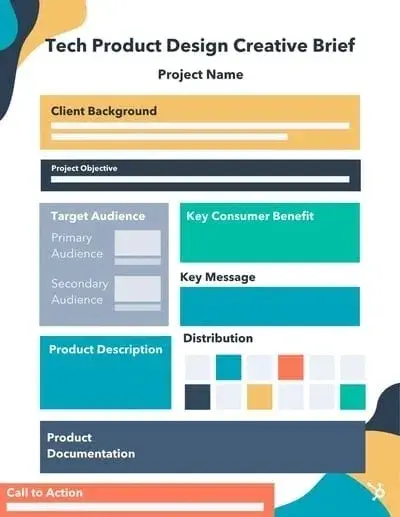
3. Advertising Agency Creative Briefs
Advertising agencies often develop creative briefs for their clients. These briefs are concise and include the client's brand guidelines as well as the specific project guidelines.
A budget may also be included in the brief so that all teams can make wise decisions about the tactics they recommend for the client.
An account manager or supervisor develops the creative brief and shares it with client stakeholders before the agency begins working on the project.
Advertising Agency Creative Brief Example
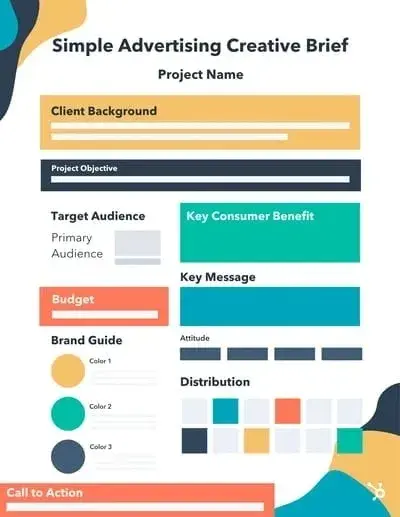
Creative Brief Examples
1. Creative Request Template
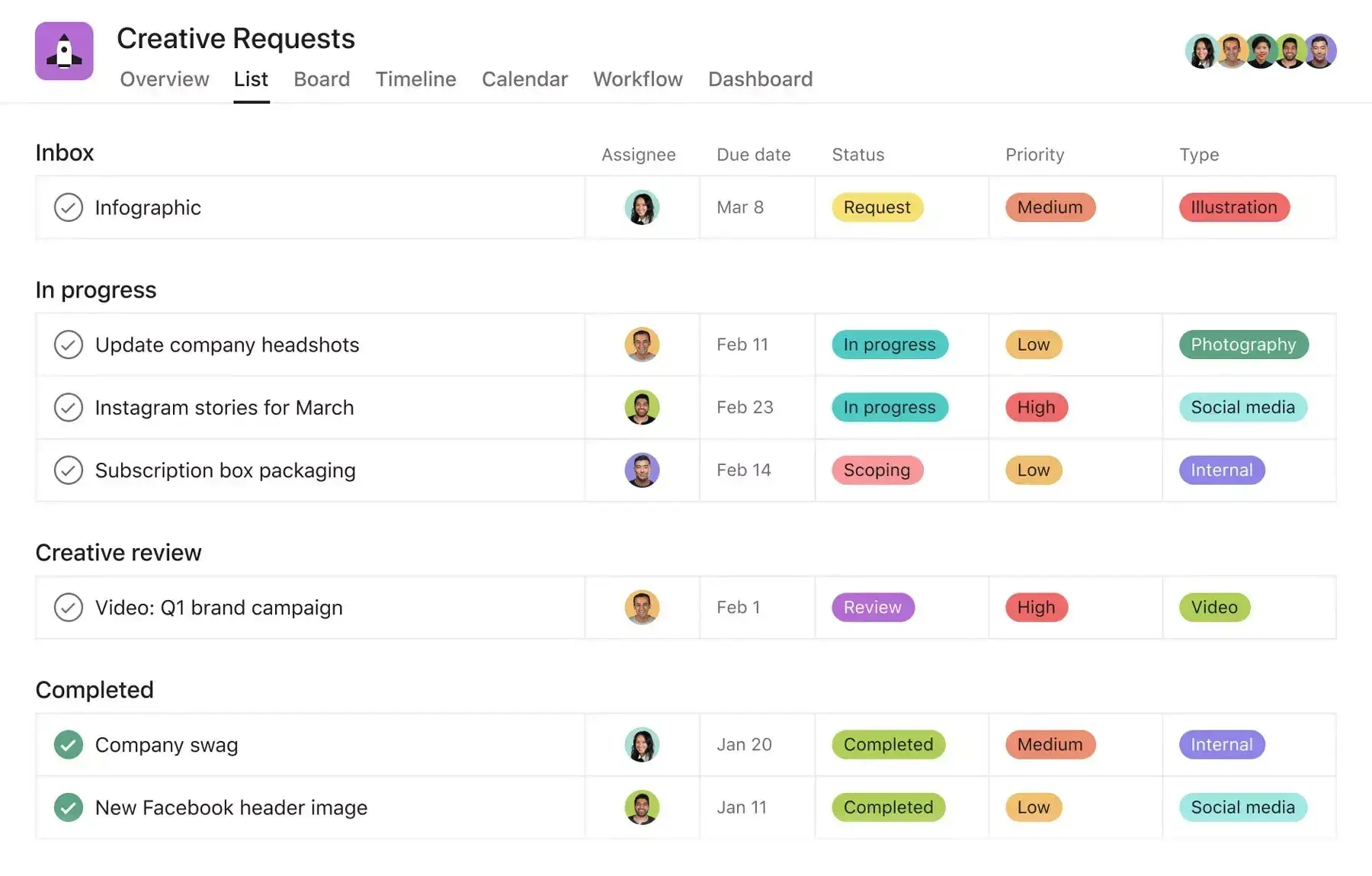
For the day-to-day management of creative projects, using a creative request template in Asana is a dynamic take on a traditionally static creative brief.
With a few tweaks to suit your business's needs, this template flows through each stage of the project while specifying tasks, deliverables, and key points that need to be included in the project.
Moreover, Asana provides several types of views that make this template easy to look at from a calendar view, list view, board view, and timeline view so you'll always know the progress of your project in relation to the creative brief.
When to Use This Creative Brief
This creative brief example is great for marketing, brand, creative, and design teams that handle a large backlog of projects with stakeholders on many different teams. Use this brief for both ad-hoc and regularly occurring projects.
2. Creative Brief Presentation Template
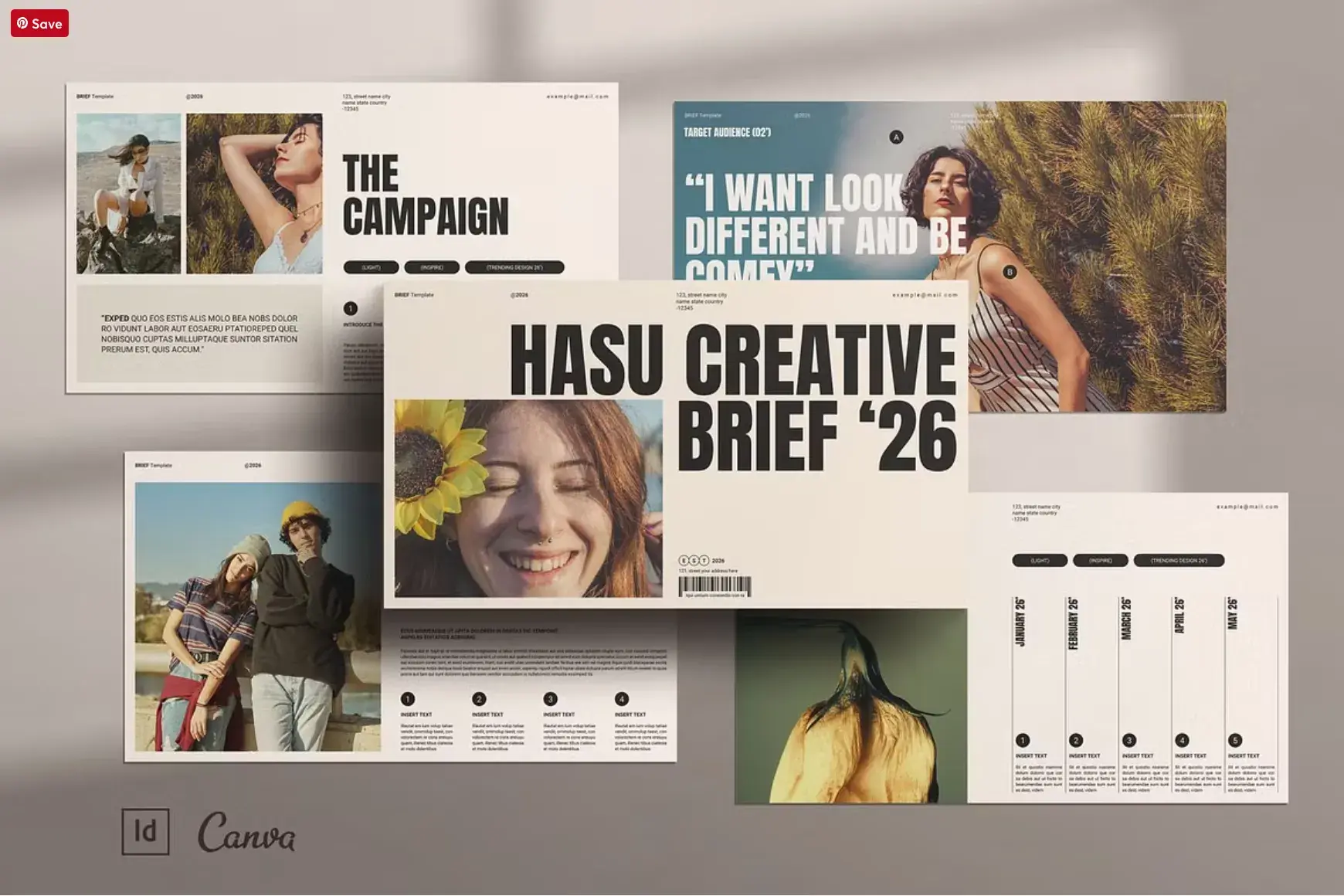
This creative brief template was designed by TemplatesForest. It's a visual-forward example of a brief that works well for long-term projects like building a business or refreshing a brand.
This longer brief includes information like internal brand insights and external competitive analyses.
When to Use This Creative Brief
Use this creative brief when you're partnering with a creative agency on bigger projects. They can use this layout to inspire a creative brief that fits your business needs.
3. Simple One-Page Creative Brief
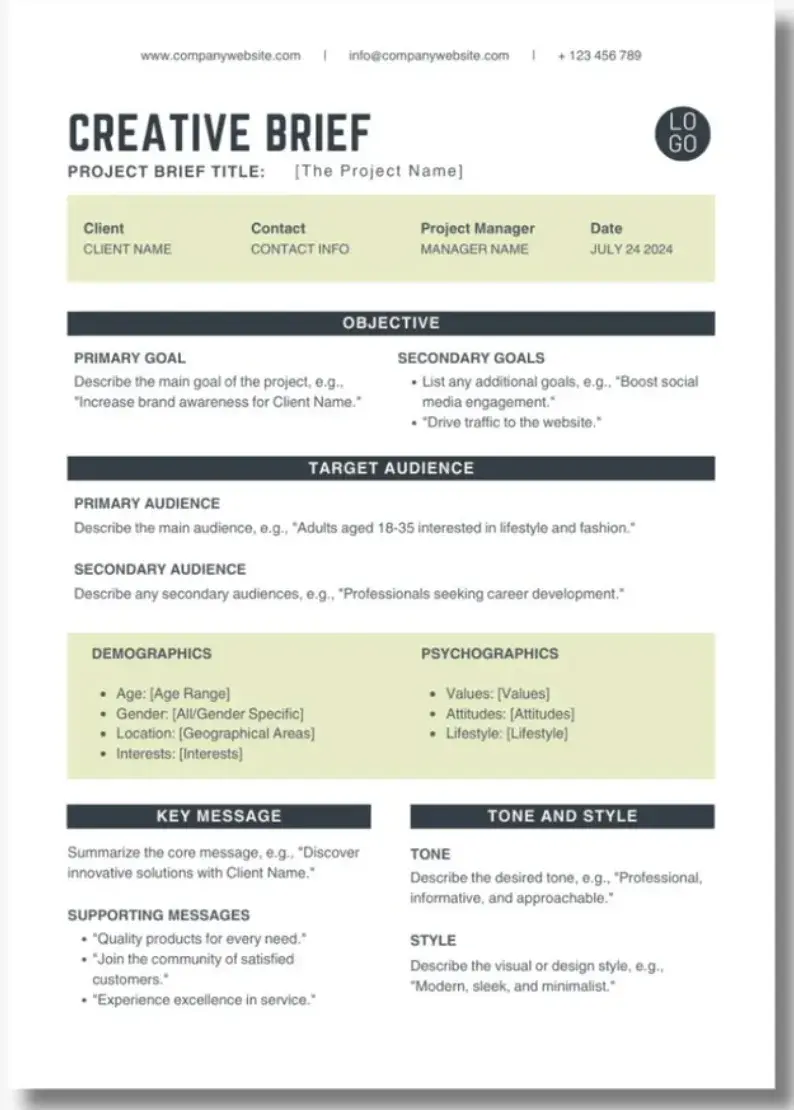
This creative brief is straightforward and simple. The only eye-catching visual is the use of the brand's logo. However, all the necessary information is included.
When to Use this Creative Brief
Use this kind of brief when you want a straightforward document detailing your brand's long-term creative projects.
4. Infographic-style Creative Brief
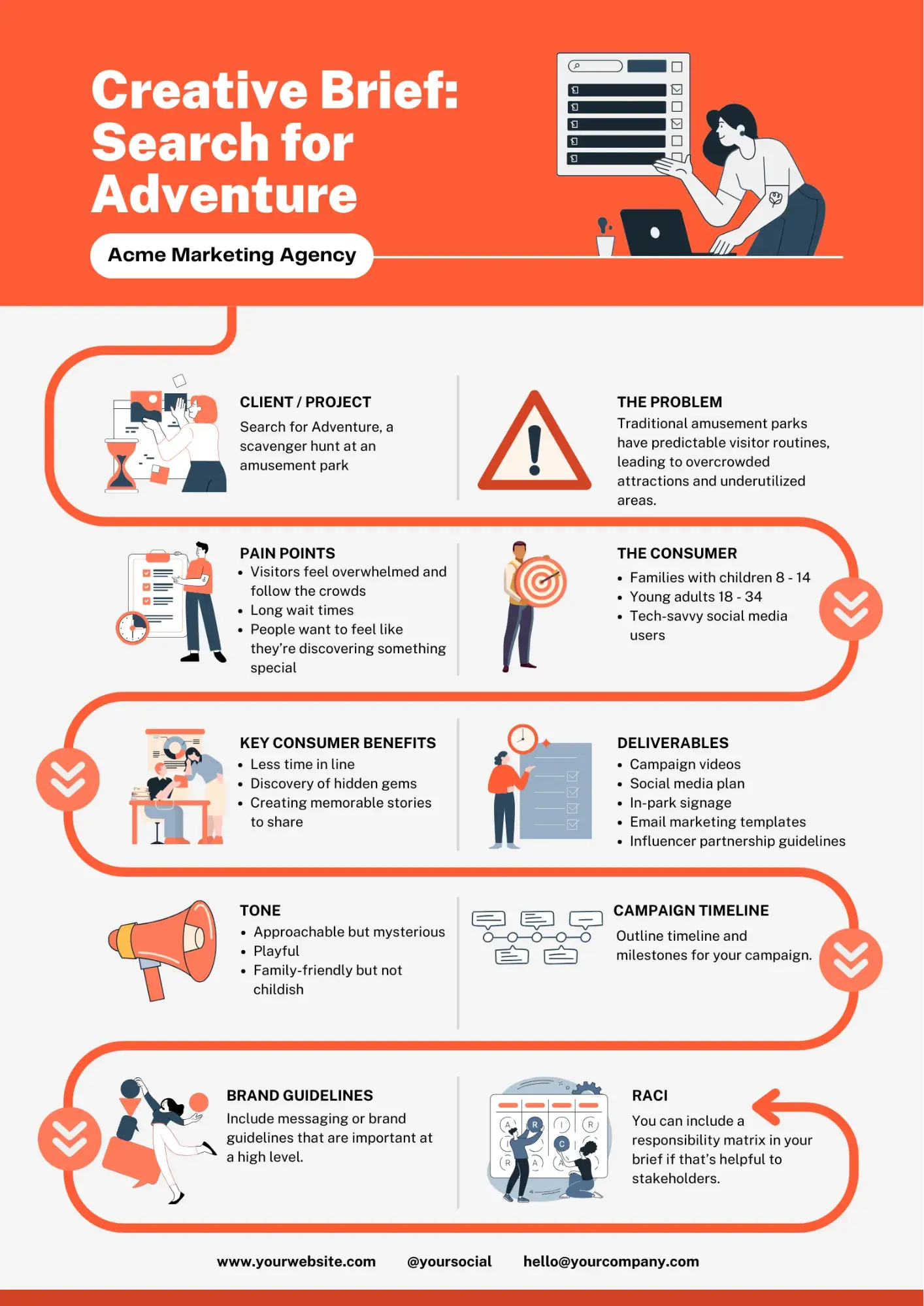
I made this infographic-style creative brief using a Canva template. It lays out the brand‘s problem, plan, and guidelines and includes visually appealing graphics to drive home the brief’s point.
When to Use this Creative Brief
A brief like the one above is most useful if your organization is embarking on a long-term project or if there's a lot of information and data that needs to be conveyed in an understandable manner. It can also be useful as a one-page version of a more detailed brief.
5. Creative Request Brief Template
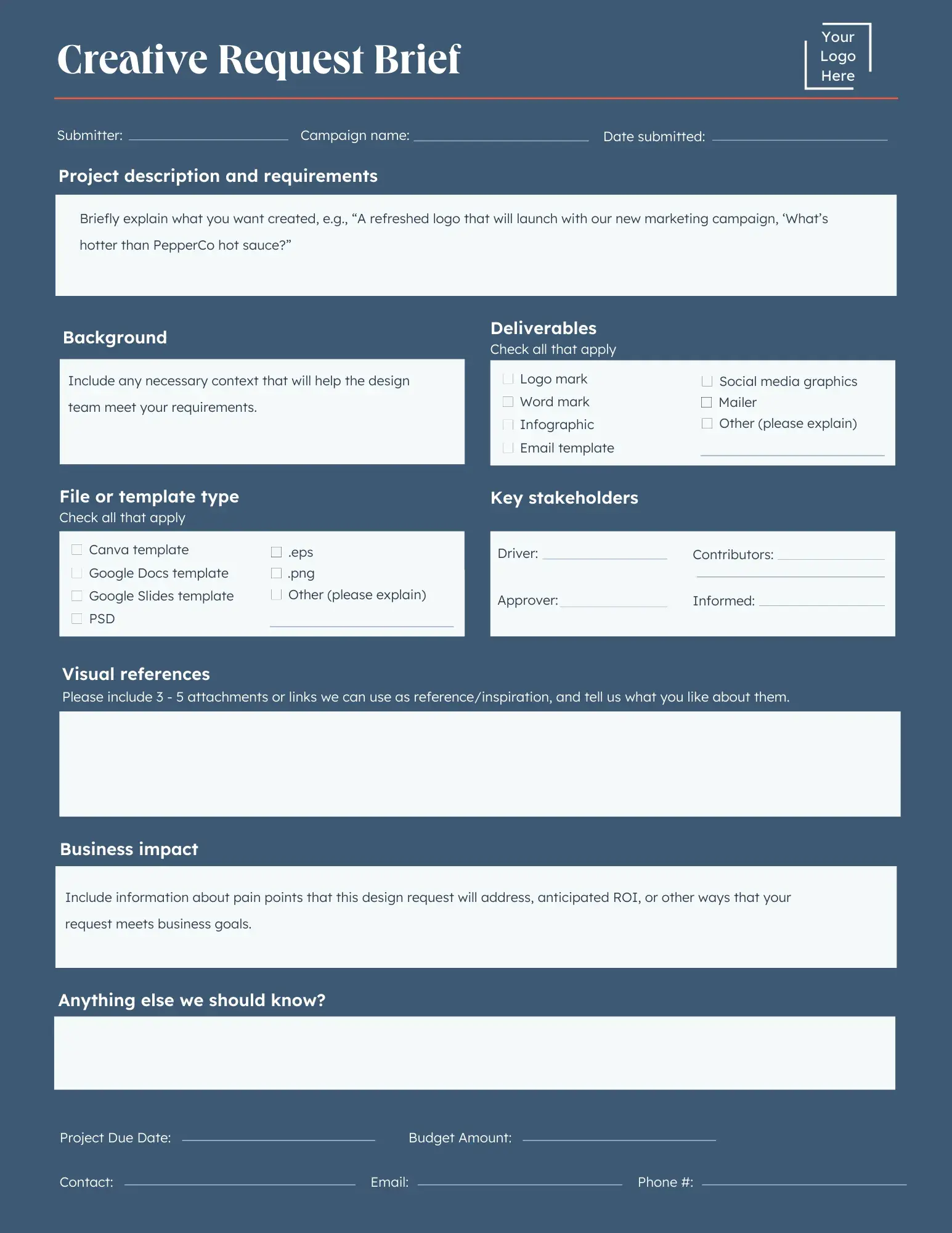
I used a Canva template to build this creative request form, which lets graphic designers gather important information from clients so that they can create a product that is aligned with the client's vision.
When to Use this Creative Brief
Briefs like this work best when working with clients on detailed projects. These can also work well on large cross-functional teams, where a graphic design team might get requests for many projects at once.
6. Canva Creative Brief
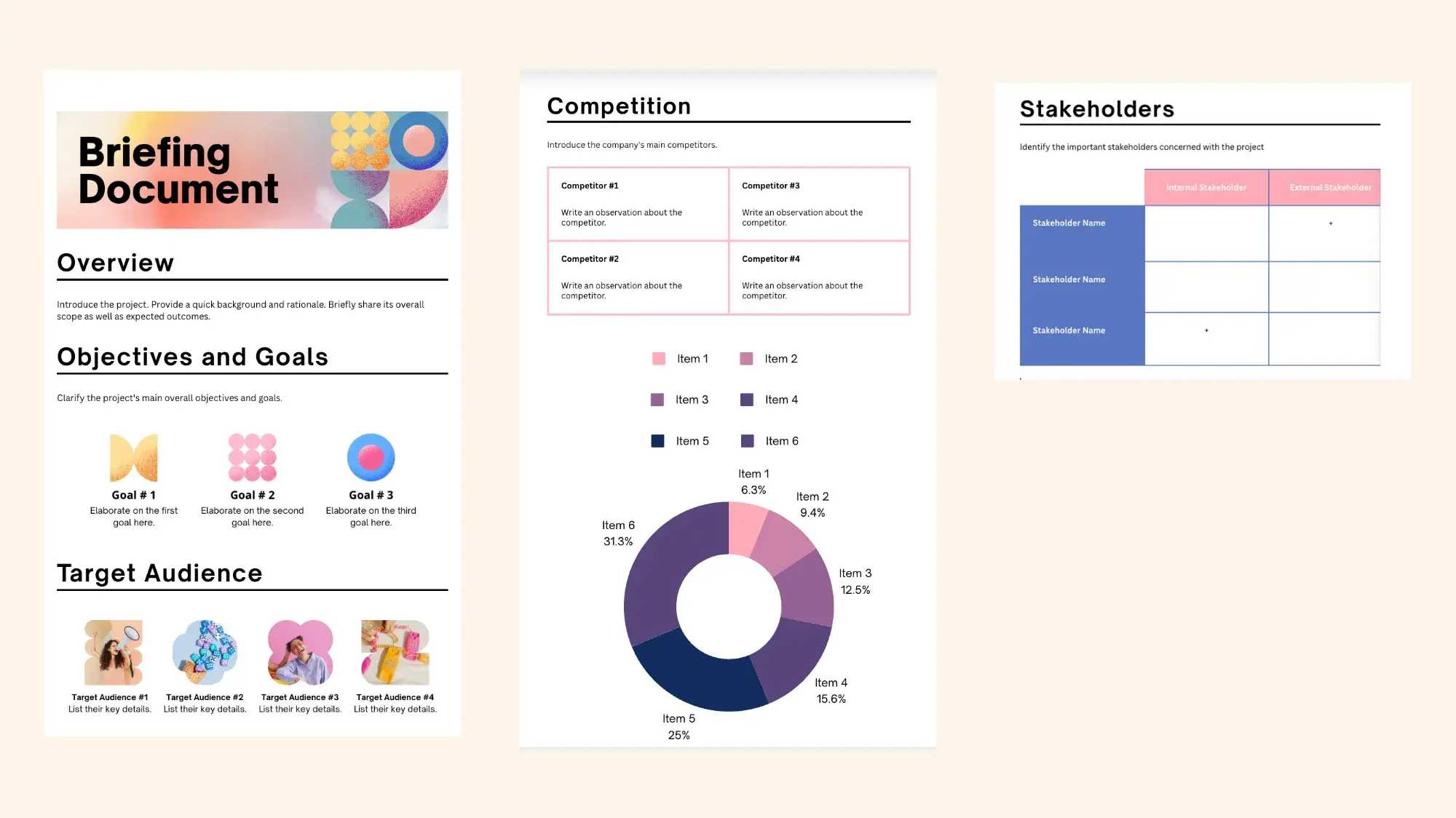
This creative brief template on Canva puts the most important elements on one long page with lots of white space. It’s also very graphics-heavy, adding visual interest and making it a pleasure to skim.
When to Use this Creative Brief
If you have a lot of information to convey, including symbols and interesting colors will help the information stick out and remain top of mind. These can also be good one-pagers to use in presentation decks.
Streamline Projects with a Creative Brief
Scope creep happens to the best of us. Projects get bigger, stakeholders are added, and the objective of the project seems to morph as time goes on.
Streamline your next product launch or marketing and advertising campaign with a creative brief. As a result, you‘ll find that your team is more aligned with the project’s goals.
We've even provided free creative brief templates to get you started — download them below.
Editor's note: This post was originally published in July 2019 and has been updated for comprehensiveness.

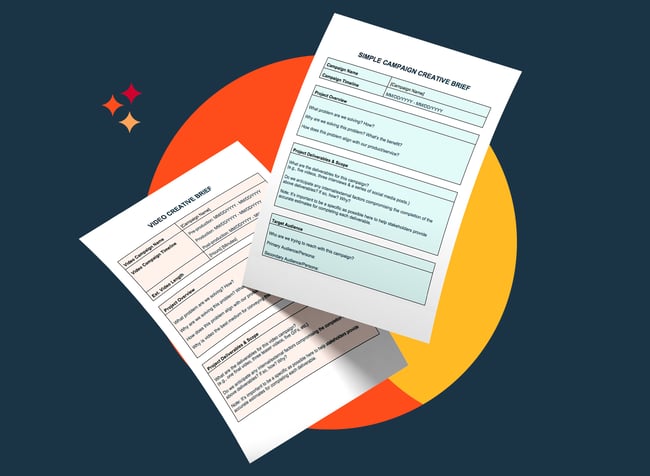

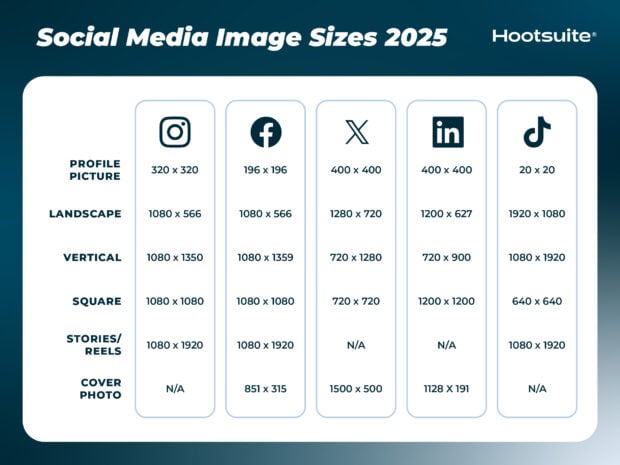
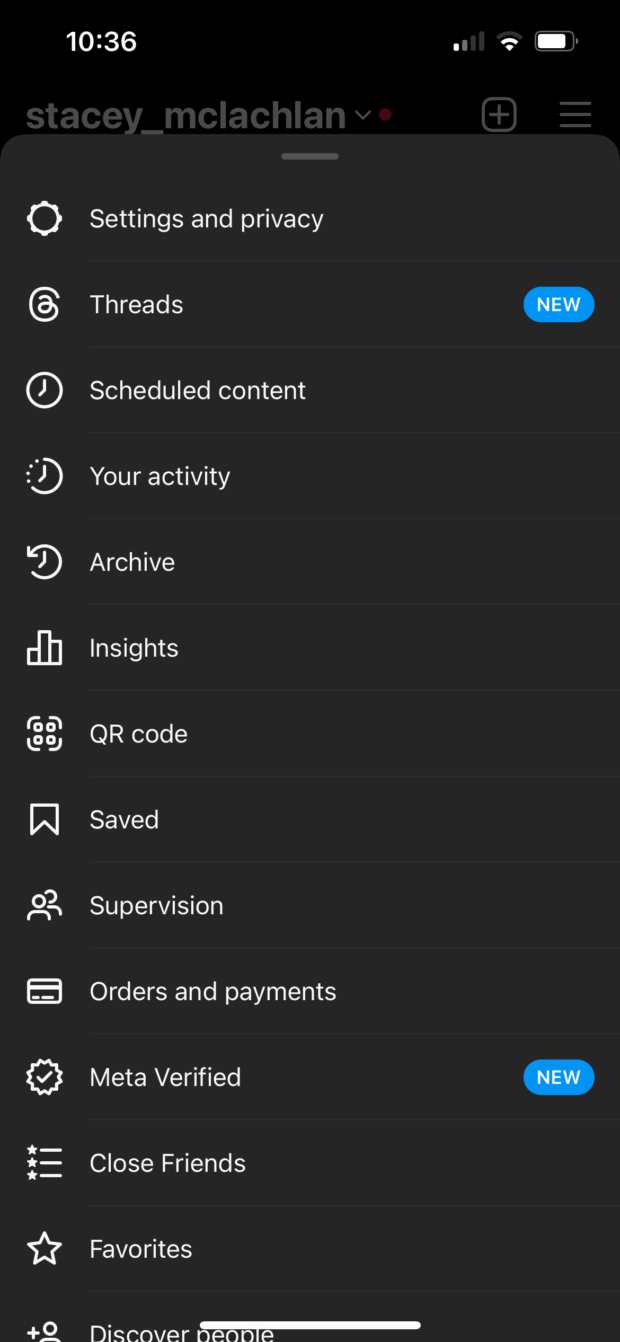

I really appreciate your insights on the importance of a creative brief in the marketing process. It’s fascinating how something so structured can actually unleash creativity by providing a solid framework. In my experience, when I’ve taken the time to sit down with project stakeholders to discuss the company’s mission and project goals upfront, the outcomes tend to be much more aligned with what everyone envisions.
You’ve touched on a crucial element of project management that often doesn’t get the spotlight it deserves — the creative brief. Your overview perfectly encapsulates its importance as a foundational element in any creative process. It’s interesting to consider how a well-constructed brief can not only clarify objectives but also foster collaboration among team members and stakeholders.
You’ve highlighted a crucial aspect of project management that often gets overlooked: the importance of a well-crafted creative brief. From my experience, the process of collaborating with stakeholders to distill the essence of a project is invaluable. It’s not just about gathering the key objectives and timelines; it’s about fostering a shared understanding and aligning everyone’s vision from the get-go.